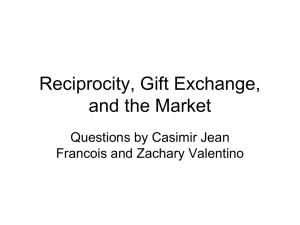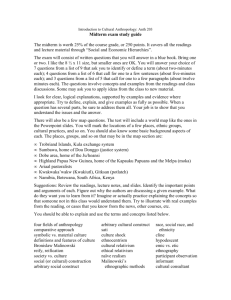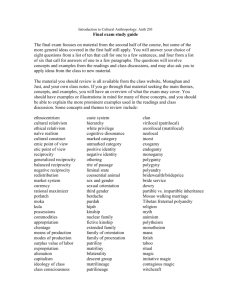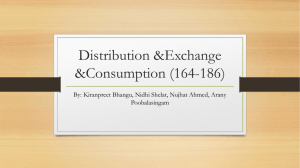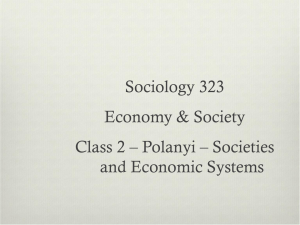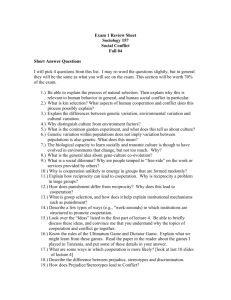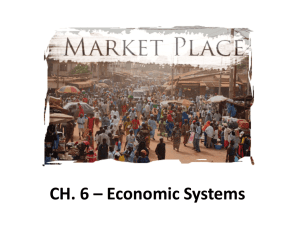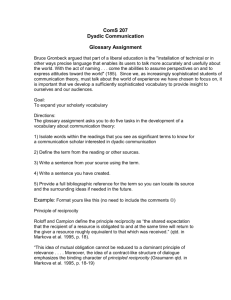Generalized reciprocity
advertisement
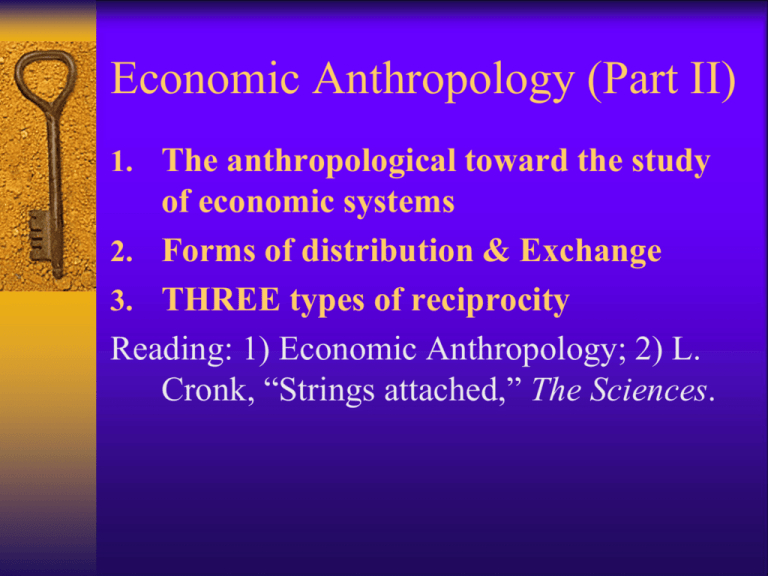
Economic Anthropology (Part II) 1. The anthropological toward the study of economic systems 2. Forms of distribution & Exchange 3. THREE types of reciprocity Reading: 1) Economic Anthropology; 2) L. Cronk, “Strings attached,” The Sciences. RECIPROCITY and Exchange in Economic Systems 1) The anthropological approach toward the study of economic systems 2) Forms of distribution and exchange 3) Types of RECIPROCITY Ethnographic Examples: KULA, POTLATCH, Cargo Cult “Life Without Chiefs”( Harris 1989) - “cultural materialism” - biological vs. social evolution - principles of reciprocity What can we learn from the “evolution of human nature?” - There is nothing inherited about the political formalism and social inequality that characterize large state societies How do anthropologists study economic systems? Anthropologists study the means by which goods are produced, distributed, and consumed in the context of the total culture of particular societies. Although they borrowed theories and concepts from economists, most anthropologists feel that principles derived from the study of western market economies have limited applicability to economic systems were people do not produce and exchange goods for profit. Formalists vs. substantivists (Karl Polanyi) Formalists Anthropologists after WWII adopted formal neoclassical economic theory while attempting to explain economic activities in non-western societies. Ex. Exchange took in a ritual context; activities and institutions that might represent a metaphorical equivalent of the capitalist market (marriage exchange) Substantivists Anthropologists who suggested capitalist market exchange is but one mode of exchange. Nonwestern societies have devised alternative modes of exchange that distribute material goods in a manner that is consistent with their basic values, institutions and assumptions about the human condition. The various culturally shaped patterns of economic activities should be the focus of analysis. Three forms/modes of exchange Reciprocity: Products, gifts, and objects are passed back and forth with the aim of: 1) helping someone in need by sharing; 2)creating, maintaining, and strengthening relationships; 3) obtaining products made by others for oneself Redistribution: contribute products to a common pool or fund that is divided (reallocated) among group as a whole by a central authority Market: products are sold for money, which in return is used to purchase other products, with the ultimate goal of acquiring more money or accumulating more products or both. Modes of Exchange The market principle – supply & demand Redistribution TYPES of RECIPROCITY - Generalized reciprocity - Balanced reciprocity - Negative reciprocity EXCHANGE and RECIPROCITY: the anthropological/sociological perspective Exchange is a fundamental element in defining social solidarity (the “glue” of social solidarity) Exchange as a dynamic process, neverending, and constantly MUST BE RENEWED Economic/social/political relationship: The power/spirit of “gift” (Mauss 1925) Generalized reciprocity Those who give goods or services do NOT expect the recipient to make a return at any definite time in the future. A transaction that involves least conscious sense of interest in material gain. Occurring between individuals who are (or at least are normatively expected to be) emotionally attached to one another or trust each other and have an obligation to help one another on the basis of the relative need. Generalized reciprocity “cast your bread upon the waters . . .” Sustaining families in all societies One-way transfers. Charity / donation Volunteering activities The pure gift (?) as an extreme form of generalized reciprocity. Generalized reciprocity may seem altruistic, but does giving benefit the giver in various ways? Ex. No Free Gifts (Mary Douglas 1990) in GIFT (Mauss 1950) Ex. Child-rearing in North America & Fulfilling filial (孝 ) obligations in East Asia Balanced reciprocity Products are transferred to the recipient and the donor/giver expects a return in products of roughly equal value (i.e. the exchanges should “balance.”). Explicit and short term in its expectations of return. Although the value of the objects transacted is supposed to be equal, balanced reciprocity is characterized by the absence of bargaining between the parties. Trade relationship May mostly involve labor. Balanced Reciprocity “You scratch my back and I’ll scratch yours” - Exchange of holiday cards / wedding banquets - Text messages on New Year’s Eve - Japanese White Holiday (02/14; 03/14) - Exchange between “wife-givers” and “wife-takers” - And others? Negative Reciprocity Both parties attempt to gain all they can from the exchange while giving up as little as possible. Motivated largely by the desire to obtain material goods at minimal cost. No money changes hands between participants Negative Reciprocity Ex. U.N. sanctions against Iraq; War in Iraq; Bombing Libya Theft Robbery Any others? Ex. Food Poisoning and Baby Formula Scare Strings Attached Thinking anthropologically about the power of gifts Is there such a thing as a free gift? “Indian Giver” & Potlatch The power relations between the giver / donors (international development agencies) and the recipients (developing countries/ the 3rd World) Is there such a thing as a free gift? Exchange is a fundamental element in defining social solidarity (the “glue” of social solidarity) Exchange as a dynamic process, neverending, and constantly MUST BE RENEWED Economic/social/political relationship: The power/spirit of “gift” (Mauss 1925) “Indian Giving” vs. “White Man Keeping” …the point of the gift was to inaugurate a friendly relationship that would be maintained thought a series of mutual exchanges Like colonialists, most westerners were blind to the purpose of reciprocal gift-giving…we too use gifts to nurture long-term relationships of mutual obligations as well as to embarrass our rivals and foster feelings of indebtedness Failing to acknowledge this fact, esp. as we give money, machines and technical advice to peoples around the world, we run the risk of being misinterpreted and worse, of causing harm. Ex: Kula, potlatch, development aid, etc. POTLATCH - Classical case study in economic anthropology - Problems of INTERPRETATION: - Wasteful display of wealth, lavish feasting (夸 富 宴 ) ? Competing for status - Ecological perspective - The cultural politics of REPRESENTATION Food as Gift, Food as Threat: Potlatch, Reciprocity, and Exchange “Fight with food” Online exhibition: Gifting and Feasting in the Northwest Coast Potlatch http://www.peabody.harvard.edu/potlatch/default.html Potlatches, as once practiced by Northwest Coast Native American groups, are a widely studied ritual in which sponsors (tribal leaders) gave away resources and manufactured wealth while generating prestige for themselves. Potlatching tribes (such as Kwakiutl and Salish peoples) were foragers but lived in sedentary villages and had chiefs--this political complexity is attributed to the overall richness of their environment. Potlatches were social occasions given by a host to establish or uphold his status position in society. Often they were held to mark a significant event in his family (the birth of a child or a son's marriage). Potlatches are to be distinguished from feasts in that guests are invited to a potlatch to share food and receive gifts or payment. Potlatches held by commoners were mainly local, while elites often invited guests from many tribes. Potlatches were also the venue in which ownership to economic and ceremonial privileges was asserted, displayed, and formally Potlatch Every event during a potlatch highlighted the host's status by demonstrating his wealth or expounding on his inherited privileges. Ownership of such privileges determined status. Potlatches included speeches, singing, dancing, feasting, and gift-giving. Speeches, songs, and dances allowed a host to assert his ancestral privileges to the guests. Masks and headdresses worn during dances depicted the supernatural being who had "given" the dance to the host or one of his ancestors. Serving food allowed the host to demonstrate his generosity and wealth, as did distributing gifts. Problems of interpretation (or overinterpretation)? Potlatches were once interpreted as wasteful displays generated by culturally induced mania for prestige, but some anthropologists argue that customs like the potlatch are adaptive, allowing adjustment for alternating periods of local abundance and shortage. • Ecological perspective • Any examples of potlatch in the “modern world”? The Politics of Reciprocity The Kula Ring 库拉圈 1) 2) 3) System of exchange involves annual inter-island visits between trading partners who exchange highly valued shell ornaments (necklaces & armbands). Each participant is linked to two partners: one to whom he gives a necklace in return for an armband of equivalent value the other to whom he makes the reverse exchange of an armband for a necklace. Malinowski considers the motivation for the enormous expenditure of time and effort involved in kula expeditions to be fundamentally non-utilitarian "in that they [the kula valuables] are merely possessed for the sake of possession itself, and the ownership of them with the ensuing renown is the main source of their value". The development of kula partnerships has social implications They establish friendly relations among the inhabitants of different islands and maintain a pattern of peaceful contact and communication, They provide the occasion for the inter-island exchange of utilitarian items, which are shipped back and forth in the course of kula expeditions, They reinforce status and authority distinctions, since the hereditary chiefs own the most important shell valuables and assume the responsibility for organizing and directing ocean voyages. Kula ring 库拉交易圈 A most elaborate complex of ceremony, political relationships, economic exchange, travel, magic, and social integration. Economic matters are inseparable from the rest of culture (the economics is not realm unto itself) Just as true in modern industrial societies as it is in traditional Trobriand society. Example: when the US stopped trading with Cuba, Haiti, Iran, Iraq, and Serbia, it was for political rather than economic reasons. Economic embargoes are popular political weapons. The Trobrianders of Papua New Guinea (Weiner 1988) Weiner’s work in the Trobriands led to a major reassessment of Malinowski's conceptualizations of Trobriand culture, adding to the tapestry the integral role of women in Trobriand kinship, political economy, and exchange. provides a balanced view of the society from a male and female perspective Gives attention to women’s productive work— distribution of their own wealth -- bundles of banana leaves and banana fiber skirts which are exchanged with other women in commemoration of someone who had recently died. Take women’s economic roles more seriously Male bias in Malinowski’s classical field research? Male bias in Malinowski’s classical field research? 人类学者怀娜重特布里安群岛,对岛上妇女的活 动和交易模式进行田野考察。在《女人有价,男 人有名》(Weiner 1976)一中,怀娜勾勒出被 马林诺斯基完全忽略了的由女性主导的一个生产、 交换和社会网络的地方文化景观。根据马林诺斯 基的田野记述,岛上的男子交换贝壳、番薯和生 猪。而怀娜发现,岛上的经济活动应加入妇女交 换芭蕉叶和制作精致的草裙,才能真正还原实地 生活图景。尽管在马林诺斯基留下的照片和笔记 中,有证据表明妇女们有交换被她们视为财富的 芭蕉叶的习俗。而直至近半个世纪之后,怀娜才 重新“发现”了这一妇女经济活动传统。马林诺 斯基之所以对妇女间如此活跃的交易活动熟视无 睹或者说视而不见,主要是他认为芭蕉叶不具备 消费物品的一般特征。在他看来,只有能够满足 人的生物生存需求的活动才是“经济性”的(而 芭蕉叶子又不能当饭吃)。他可能压根就没有把 Cargo Cults (船货崇拜) “cargo” – pidgin English for traded goods (plus knowledge of white magic power) Prophecy fulfilled: the arrival of the whites as the sign that the end of the world was at hand; “receiving the news of the millennium” The collision of “European civilization with the indigenous cultures of the SW Pacific.” Cult was well-organized: forms of local resistances/cultural fusion The acceptance of Christianity did not bring cargo any nearer (not the whites but dead ancestors made the cargo) The cults reflect quite logical and rational attempts to make sense of a social order that appears to be chaotic Cargo never comes; cults live on. Scattered groups were brought together. Concept review: EXCHANGE Reciprocity Back-and-forth exchange of products, gifts, and objects, symbolic of relationships as well as satisfying material needs and wants. Redistribution Collection of products and valuables by a central authority, followed by distribution according to some normative or legal principle. Market Free exchange of products or services for money at prices determined by impersonal forces of supply and demand. Q: Is there such a thing as a “pure gift?”

